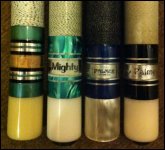have a customer that wants clear windows in a cue, like some of the palmers. i bought some acrylic tube to use as the window, but it seems to chip, when i try to cut it, and i cannot sand or repolish it. would a polycarbonate tube be better ??
any suggestions as how to cut or polish the acrylic, or maybe a different material ???
any suggestions as how to cut or polish the acrylic, or maybe a different material ???
